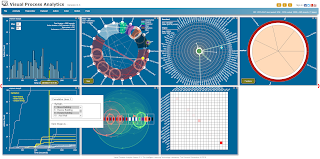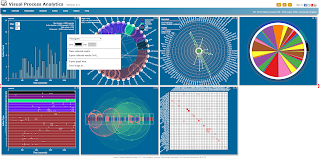 Visual Process Analytics (VPA) is a data mining platform that supports research on student learning through using complex tools to solve complex problems. The complexity of this kind of learning activities of students entails complex process data (e.g., event log) that cannot be easily analyzed. This difficulty calls for data visualization that can at least give researchers a glimpse of the data before they can actually conduct in-depth analyses. To this end, the VPA platform provides many different types of visualization that represent many different aspects of complex processes. These graphic representations should help researchers develop some sort of intuition. We believe VPA is an essential tool for data-intensive research, which will only grow more important in the future as data mining, machine learning, and artificial intelligence play critical roles in effective, personalized education.
Visual Process Analytics (VPA) is a data mining platform that supports research on student learning through using complex tools to solve complex problems. The complexity of this kind of learning activities of students entails complex process data (e.g., event log) that cannot be easily analyzed. This difficulty calls for data visualization that can at least give researchers a glimpse of the data before they can actually conduct in-depth analyses. To this end, the VPA platform provides many different types of visualization that represent many different aspects of complex processes. These graphic representations should help researchers develop some sort of intuition. We believe VPA is an essential tool for data-intensive research, which will only grow more important in the future as data mining, machine learning, and artificial intelligence play critical roles in effective, personalized education.
Several new features were added to Version 0.3, described as follows:
1) Interactions are provided through context menus. Context menus can be invoked by right-clicking on a visualization. Depending on where the user clicks, a context menu provides the available actions applicable to the selected objects. This allows a complex tool such as VPA to still have a simple, pleasant user interface.

 2) Result collectors allow users to gather analysis results and export them in the CSV format. VPA is a data browser that allows users to navigate in the ocean of data from the repositories it connects to. Each step of navigation invokes some calculations behind the scenes. To collect the results of these calculations in a mining session, VPA now has a simple result collector that automatically keeps track of the user’s work. A more sophisticated result manager is also being conceptualized and developed to make it possible for users to manage their data mining results in a more flexible way. These results can be exported if needed to be analyzed further using other software tools.
2) Result collectors allow users to gather analysis results and export them in the CSV format. VPA is a data browser that allows users to navigate in the ocean of data from the repositories it connects to. Each step of navigation invokes some calculations behind the scenes. To collect the results of these calculations in a mining session, VPA now has a simple result collector that automatically keeps track of the user’s work. A more sophisticated result manager is also being conceptualized and developed to make it possible for users to manage their data mining results in a more flexible way. These results can be exported if needed to be analyzed further using other software tools.
 3) Cumulative data graphs are available to render a more dramatic view of time series. It is sometimes easier to spot patterns and trends in cumulative graphs. This cumulative analysis applies to all levels of granularity of data supported by VPA (currently, the three granular levels are Top, Medium, and Fine, corresponding to three different ways to categorize action data). VPA also provides a way for users to select variables from a list to be highlighted in cumulative graphs.
3) Cumulative data graphs are available to render a more dramatic view of time series. It is sometimes easier to spot patterns and trends in cumulative graphs. This cumulative analysis applies to all levels of granularity of data supported by VPA (currently, the three granular levels are Top, Medium, and Fine, corresponding to three different ways to categorize action data). VPA also provides a way for users to select variables from a list to be highlighted in cumulative graphs.
Many other new features were also added in this version. For example, additional information about classes and students are provided to contextualize each data set. In the coming weeks, the repository will incorporate data from more than 1,200 students in Indiana who have undertaken engineering design projects using our Energy3D software. This unprecedented large-scale database will potentially provide a goldmine of research data in the area of engineering design study.
For more information about VPA, see my AERA 2016 presentation.
